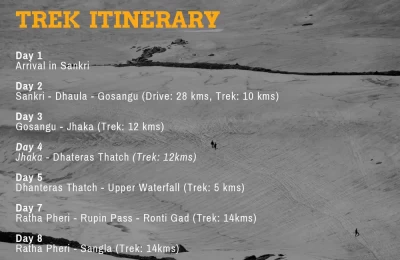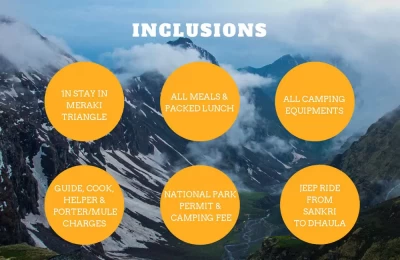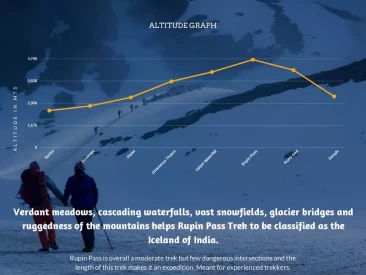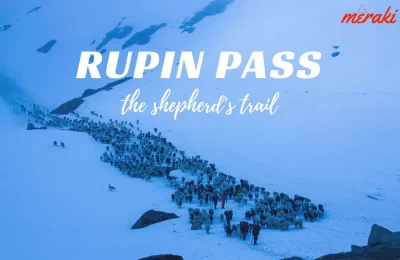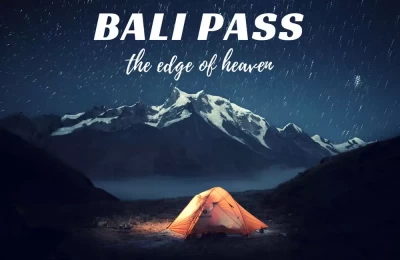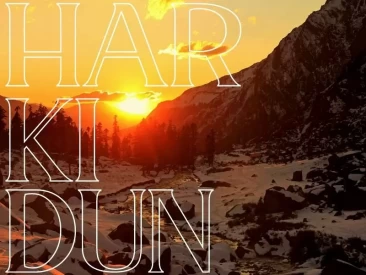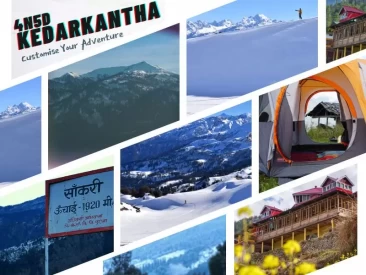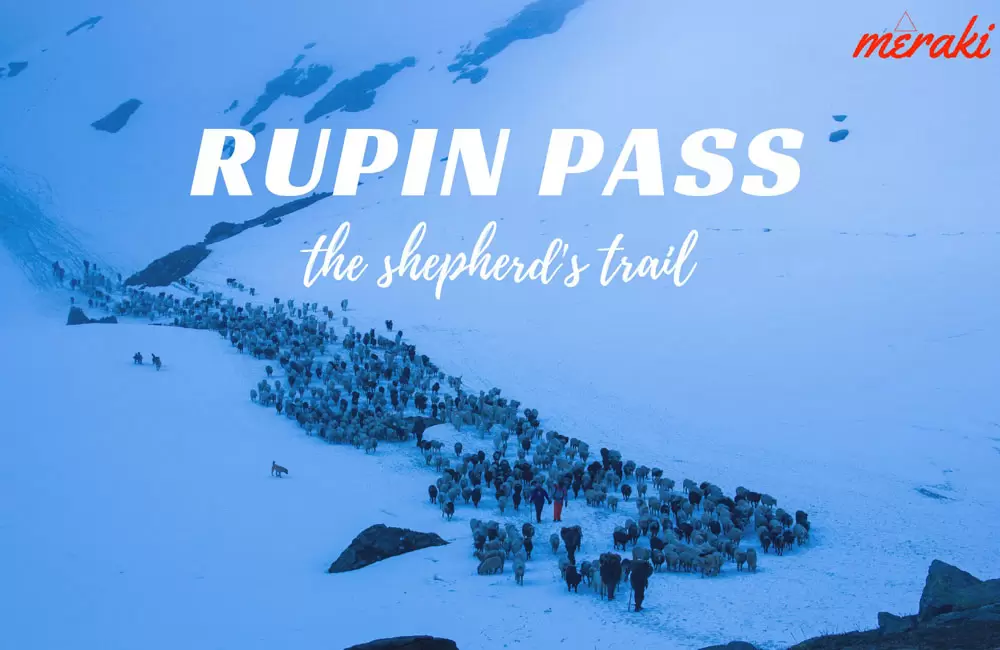
Rupin Pass ex-Sankri Trekking Tour
Price Table
| Rupin Pass Trekking Expedition ex-Sankri | |
| Cost Per Person | Rs 24500 |
Note: The costing is for Indian Nationals only, as per group size. Additional charges will apply for Foreign Nationals due to permits and camping/entry fees.
Package Highlights
- Stay at Wooden House – Meraki Triangle Sankri
- Culturally diverse villages
- Trans-himalayan high altitude pass
- Surreal Dhanteras Valley with giant glacial waterfalls
- Amazing campsites on every day of the trek
- Small Group Size - Freedom to Explore more
- Professional and certified guides with experienced cooks
High altitude verdant meadows, cascading waterfalls, glacier bridges, vast snowfields and a thrilling climb to reach 4650mts makes Rupin Pass one of the most celebrated trans Himalayan trek. Rupin Pass Trek begins from Govind Ballabh Pant National Park in Uttarakhand and ends at the far corner of Kinnaur in Himachal.
Rupin Pass is overall a moderate trek but few dangerous intersections and the length of this trek makes it a high altitude expedition. Rest assured after completing this trek, your greed for beautiful and challenging treks will multiply.
Region: Garhwal in Uttarakhand to Kinnaur in Himachal
Best Season: May to October
Altitude Range: 1510 mts to 4650 mts
Grade: Moderate
Short Itinerary for Rupin Pass Tour Package
Day 1 : Arrival at Sankri
Day 2 : Sankri - Dhaula–Sewa - Gosangu
Day 3 : Gosangu - Jhaka
Day 4 : Jhaka – Saruwas Thatch
Day 5 : Saruwas Thatch – Dhanteras Thatch
Day 6 : Dhanteras Thatch – Upper Waterfall Top – Ratha Pheri
Day 7 : Rathi Pheri - Rupin Pass - Ronti Gad Meadows
Day 8 : Ronti Gad Meadows – Sangla Kanda - Sangla
Tour Itinerary
Day 1Arrival at Sankri
Arrive at Sankri Village, meet our host and rest at our Homestay in Sankri (Meraki Sankri). If time permits you can explore the village or just walk around Sankri for a peaceful evening.
Check how to reach Sankri here and Things to do in Sankri.
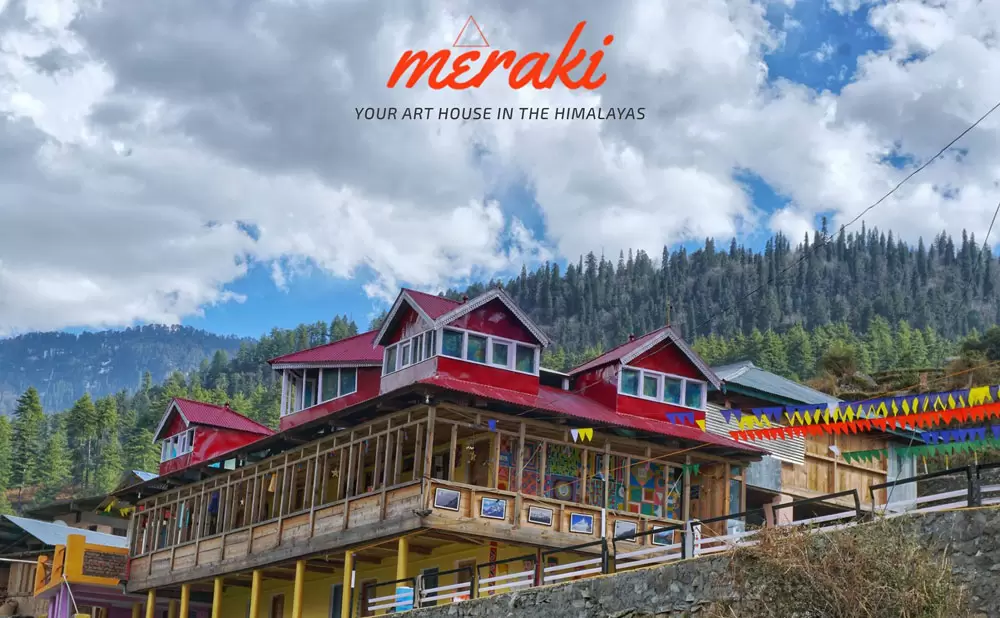
Day 2Sankri - Dhaula–Sewa - Gosangu
After breakfast, drive from Sankri to Dhaula. Follow an under-construction road which is being built to connect Dhaula with Sewa. After walking for a couple of kilometers you will come across a well-defined trail. While trekking you will constantly see the Rupin River flowing towards your right. A sharp turn on the trail and you will start walking towards the cliff. After a few hours, you will reach the Sewa Temple.
The temple has a unique structure which depicts the cultural mix of Jaunsari and Kinnauri people. Rest for a while at the ground near Temple and then continue trekking towards Gosangu. Soon you will be walking right next to the beds of the gushing Rupin River. Continue trekking to reach a bridge over a small stream, Holi Gadh which acts as the border between Uttarakhand and Himachal. Gosangu is not far from here.
Day 3Gosangu - Jhaka
Follow the road which is being built to connect Gosangu with Jiskun. For the most part of this trekking stretch, the trail is evenly laid with occasional climbs. After reaching Batwa the trail climbs and goes around a ridge to enter Jiskun Village. Jiskun is a large village with some shops to stock up ration. Jhaka becomes visible from Jiskun Village.
The trail from Jiskun to a bridge over a small stream is flat with a short descent followed with a steep climb to Jhaka Village (2650mts). After climbing halfway into the climb you'll encounter will be made trail going left which goes to Dhara Village, ignore it and continue trekking towards the original trail which ends sup at Jakha.
Jhaka is the last place to stock up your supplies. You can either camp at the school ground in Jhaka or stay at a village homestay.
Day 4Jhaka–Saruwas Thatch
After laid back hiking for previous 2 days, this trekking stretch will start bringing surprises at every turn. Jhaka is a large village and it will take you almost an hour to exit its boundary and fields. Soon you’ll reach a beautiful pine forest. Do make some voice while hiking through this stretch and walking in a group because this region is frequented by bears.
After crossing the trail a sharp descent brings you to the busy Rupin River meandering through sharp cliffs navigating its way. For the first time during this trek you will cross the river and follow the trail on the right. After hiking for a few kilometers you'll come across a lush area called Buras Kandi which makes a good campsite in case of emergencies.
The trail climbs up from Buras Kandiand enters a forest rich in Rhododendrons (buransh). Soon you'll reach Saribasa Thatch where Rupin River spreads out forming a wide river bed. There are a few camping options available at Saruwas Thatch. This area is facing naked rocky cliffs and is rich in Birch tree
Day 5 Saruwas Thatch (3250mts) – Dhanteras Thatch (3500mts)
This is the most beautiful day of the Rupin Pass Trek. The trail is short and sweet with the occasional punch of adventure where you get to traverse snow bridges.
Once you cross the second snow bridge you'll reach a scenic spot where the Rupin River flows gently enough to form a still pool of crystal clear water. This makes a good campsite but Dhanteras Thatch is well within reach so it is better to hike further.
An hour of hiking and you’ll reach the widespread lush green meadows of Dhanteras Thatch. Rupin Waterfall is a treat to eyes and so is the view of the Rupin Valley if you look back. At Dhanteras Thatch you might realize that this is the best campsite you ever stayed in.
Note: We may complete Jhaka – Dhanteras Thatch (Day 04 & Day 05) in one day in order to save 1 Buffer Day for the trek. Weather is unpredictable at high altitude which might slow us down later.
Day 6Dhanteras Thatch (3500mts) – Upper Waterfall Top – Ratha Pheri (4350mts)
From Dhanteras Thatch it is 1 km walk on flat meadow till you reach the foot of the Rupin Waterfall. The climb to the waterfall top goes through some tricky intersections and glacier bridges. During May and June, most of the trail from Dhanteras Thatch to crossing Rupin Pass will be covered with snow but in September and October, you will have to traverse on boulders and just a few snow bridges.
It takes around 2 hours to reach the top of Upper waterfall from the foot of the Rupin Waterfall. Overlooking the Rupin Valley, Upper Waterfall Top makes a stunning campsite. If you are not well acclimatized then camp here and cross the Rupin Pass the next day while skipping the camp at Rathi Pheri.
Stretching the trek up to Rathi Pheri on the same day has its advantages. The trail from Upper Waterfall Top to Rathi Pheri involves steep climb and an altitude gain of another 350 mts. Thus, camping at Rathi Pheri will make the crossing of Rupin Pass and reaching Ronti Gad Meadows less tiresome.
Day 7Rathi Pheri (4350mts) - Rupin Pass (4650mts) - Ronti Gad Meadows (4100mts)
A long walk starts from Rathi Pheri on boulders followed with vast snowfields. Soon you’ll spot the Rupin Pass Gully in the Dhauladhar ridgeline. It is one steep climb from the base of the Rupin Gully to Rupin Pass. During May and June, the gully will be covered with hard slippery snow. Cutting steps with an ice ax and shoe spikes are a must if trekking during this time because one slip will take you back to the base.
During September and October, the gully will be devoid of snow but it will be full of loose gravel. You might even use your hands while climbing the Rupin Pass Gully, yes, it is that steep. You’ll see several cairn markings at Rupin Pass.
The lofty Kinner Kailash peaks will be the first thing you’ll notice after reaching Rupin Pass along with the glimpse of Sangla Valley. Perform a pooja for safely reaching the pass.
A sharp descent over boulders covered with snow awaits you on another side of the Rupin Pass. After a couple of kilometres, you’ll encounter snow-covered slopes spreading down to the Ronti Gad Meadows. It is a long but rewarding walk to Ronti Gad meadows.
Day 8Ronti Gad Meadows – Sangla Kanda - Sangla
Ronti Gad is a beautiful meadow that show cases the vividity of green pasture. You may encounter flock of sheeps while traversing this stretch. After laid back walk for couple of hours you’ll see acquaint little hamlet, Sangla Kanda.
Sangla Kanda acts as the temporary summer settlements for the people living in the villages of Sangla valley. They come here during summer to grow their crops and graze their herds. It takes another 6kms to reach Sangla from Sangla Kanda.
After reaching Sangla you need to cross a bridge over the Baspa River followed with a steep climb to the market of Sangla town. Our trek service will ends after reaching Sangla.
*Note: Keep 1 Day as buffer (in case required to weather or any reason). It will be charges on pro-rata basis if utilized.
Customize this Tour Rupin Pass ex-Sankri Trekking Tour
Reach out to us to customize this tour package as per your requirments, group size, transport upgrade, hotel upgrade and modify inclusions or exclusions.Package Inclusions
- Accommodation in Meraki Sankri Homestay (best stay in Sankri) or Similar
- Premium Dome tents during trek on twin/triple sharing
- All Meals (from your arrival at Sankri until reaching Sangla)
- Trek Fees, All Trekking equipment (Tents, Sleeping Bags, Kitchen tent, toilet tents, etc)
- Porter, Cook & Mule charges
- Mountaineering Certified Guide, Services of Experienced Trek Leader
- Transportation from Sankri to Dhaula
- Camping Charges & National Park Fees (for Indian Citizens only)
- Transfers of Support Staff from Sangla to Sankri
Package Exclusions
- Transportation (from Dehradun)
- Accommodation and meals in Sangla is not included
- Any other personal expenses
- Anything not mentioned in inclusions
Important Information
Note: Important Things to Carry during trekking
For more information, you can contact our travel advisor on Email/Call/WhatsApp
Why we prefer private and small groups? We love to trek in smaller private groups as we believe that it gives the best ambience to experience the Himalayan spirituality, serenity, solitude and rawness. Small groups are also eco friendly, less noisy, safe, friendly, easy to manage and more caring towards each other. Most importantly, private groups are more focused towards their objective which is to enjoy being in the nature. We specialize in arranging customized private groups catering to the specific needs.
Why Book Your Trek with us?
- Smaller Groups with customized and quality services
- Stay in better tents/hotels and homestays
- Upgraded and quality meals
- Local, Experienced and Certified Guides
- Transparent, Flexible and Customer Friendly team
- No compromise on safety standards
- We organize eco-friendly and responsible treks
Cancellation Policy
- Within 15 days of Arrival Date/ No Show: No Refund
- 15 Days to 30 Days prior to Arrival: 50% of the total package cost.
- 30 Days & More: 10% of package cost (and taxes are not refunded in any case)
- Note: No refunds in case of Road Blocks, Accidents, etc
Why book with eUttaranchal?
- Largest online travel portal of Uttarakhand since 2003 with Authentic and Latest Information.
- Self visited destinations, hotels before recommending to guests.
- Hundreds of trusted local guides, hotels, taxi operators, tour operators associated with eUttaranchal.
- Dedicated region specific sales team with in-depth knowledge of Uttarakhand.
- One of the most trusted website of Uttarakhand.
About eUttaranchal
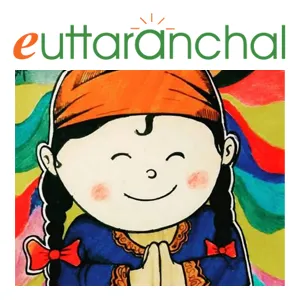
Seeded in 2003, eUttaranchal is a travel company specializing in Char Dham Helicopter Tours and Trekking across Uttarakhand. We are registered as an Adventure Tour Operator with Uttarakhand Tourism. We are also one of the most followed pages of Uttarakhand on social media.

